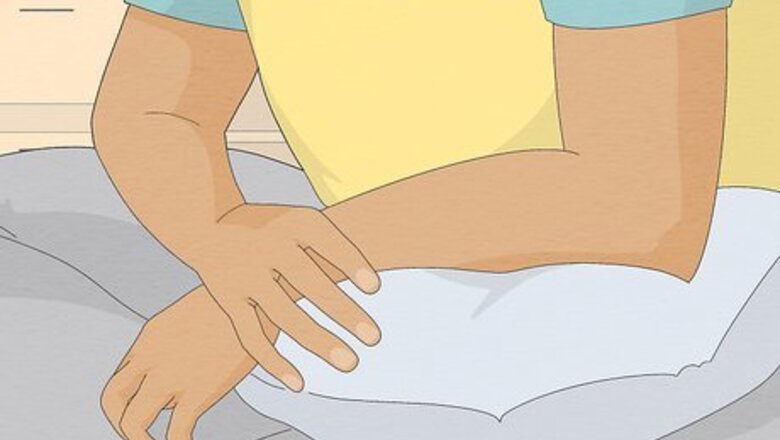
views
- If you have pitcher's arm, it's really important to rest for at least a few days, or as long as it takes to start feeling better.
- You can help relieve soreness and inflammation from pitcher's arm by holding an ice pack or a bag of frozen vegetables against your upper arm for about 15-20 minutes at a time.
- Other at-home treatments include using compression bandages, elevating your arm, and taking OTC pain medication.
- If the pain doesn't go away after a few days, see your doctor to determine if you have an injury.
Reducing Pain and Inflammation
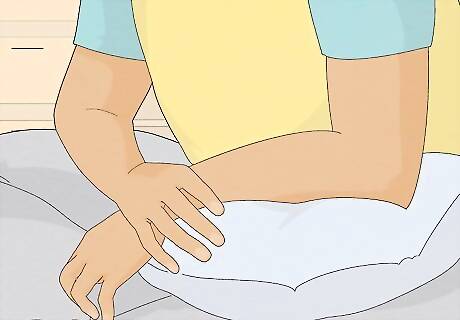
Rest a sore arm. Professional pitchers often say you can pitch through a “dead arm,” which is more of non-specific fatigue, but even they don’t try to pitch through a sore arm. Soreness is the body’s way of saying that muscles have been over-stressed and may even have suffered micro-tears. Time and rest are essential to heal sore muscles. Rest your arm for at least a few days, if not a few weeks, to give it a chance to recover. Pitching with a sore arm causes an increase in the risk of a significant elbow or shoulder injury. Follow the recommended or required limits for pitches or innings, and for rest between outings, to limit the likelihood of soreness in the first place. However, always listen to your body first — if your arm is sore, do not pitch until it feels better.
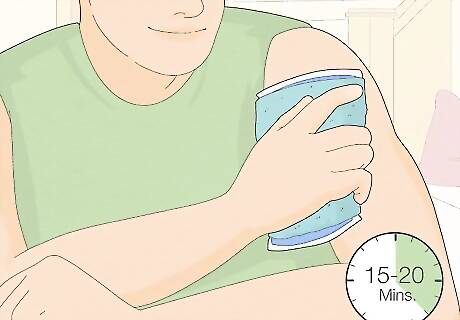
Ice your arm. At any professional ballgame, you are likely to see the starting pitcher in the dugout with his arm wrapped in ice after his outing is complete. Ice has been used for decades to help address pitching arm soreness by reducing inflammation. It should be applied to the upper arm and shoulder areas immediately after a pitching performance, and as needed thereafter. If you don’t have ice, then you can also use a bag of frozen vegetables, such as frozen peas or corn, to ice your arm. Wrap the bag of vegetables in a paper towel and place it on your upper arm. Make sure that you remove ice after about 15 to 20 minutes and then allow your skin to return to its normal temperature before using ice again.
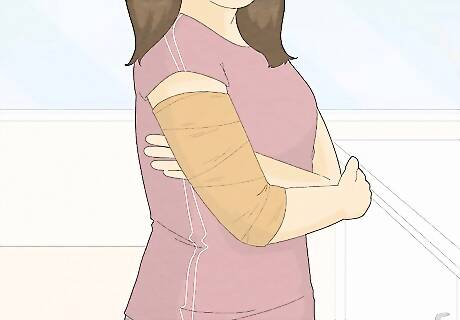
Compress the arm. Compressing your arm can also help with recovery, especially if there is any swelling in your arm. Get a compression stocking or ACE bandage that you can apply to your upper arm. Wrap the upper part of your arm so that it is snug, but not too tight.

Elevate the arm. Elevating your arm may also help with recovery. Try placing your arm up on a couple of pillows while you are sitting. Keep it raised above the level of your heart. This may help to reduce swelling.

Take an over-the-counter pain medication. Over-the-counter non-steroidal anti-inflammatory drugs (NSAIDs) can also help reduce arm soreness temporarily. However, never use medications as a way to mask pain so that you can pitch again. This is a recipe for a more significant arm injury. For example, you can take a 400 to 800 mg of Motrin every 6 hours as needed. Do not exceed the maximum dose of 3,200 mg per day. Follow the instructions for any over-the-counter pain medication that you decide to take.
Seeking Medical Treatment
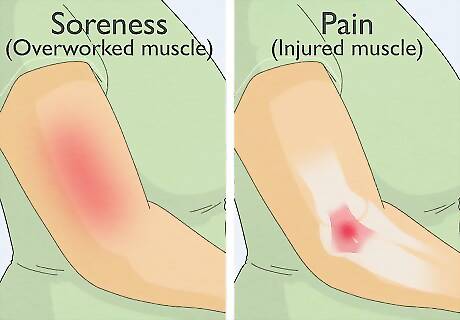
Differentiate soreness from pain. Arm soreness indicates that the muscles have been overworked or overstressed, and should usually present as a fairly consistent, dull ache in the muscles. If you have pain in the elbow or shoulder capsule, and especially if it becomes more painful depending upon arm positioning or motion, you probably have something more serious than just “pitcher’s arm.” Sore muscles improve with rest. Injured muscles, tendons, ligaments, etc. often do not. Don’t discount, ignore, or try to mask arm pain, or you may be risking a major arm injury that could end your time as a pitcher for good.
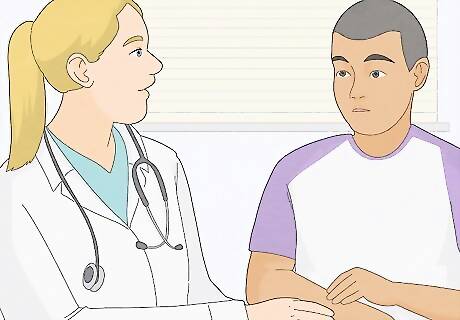
See a doctor when rest doesn’t suffice. If you have recurring arm pain or soreness that does not go away after several days of rest, consult a physician. Only a proper medical exam can determine the condition of your arm and any muscle or other problems in it. Depending upon the findings of the initial examination, the doctor may recommend an x-ray, CT scan, and/or MRI scan of the arm in question. Don’t pass up the opportunity to make use of these diagnostic tools.

Discuss treatment options with your doctor. Once the findings of any arm scans are interpreted, your doctor may recommend any number of treatment options. He or she may say that continued rest and perhaps some anti-inflammatory medications are in order. Or, the doctor may recommend physical therapy. Finally, surgery may be deemed the best option. Discuss the pros and cons and your preferences and concerns with your doctor before moving forward. Surgeries to repair the rotator cuff area of the shoulder are not uncommon for injured pitchers, but in recent years elbow surgeries have become increasingly common. Elbow ligament repair and replacement operations (the latter often called “Tommy John surgery” in honor of the first big leaguer to successfully undergo the procedure) continue to increase in number at all levels of baseball as pitching velocity (again at all levels) goes up.

Emphasize prevention as the best cure. Some people no longer see arm surgery as a big deal, and indeed many pitchers do return to their former level of performance after surgery. However, it is always preferable to avoid surgery through proper training, technique, and rest. Preventing arm soreness is easier and safer than treating it. Rest a sore arm, and always follow recommended or required pitch and inning counts and recovery periods. Give pitching arms longer periods of rest throughout the year — for youth pitchers, at least four months total and at least two or three months consecutively. As a coach, focus on teaching good mechanics and remove pitchers once signs of fatigue or poor mechanics appear. Take special precautions when youth pitchers are throwing in high-pressure situations like a championship game, a “showcase” for college recruiters or pro scouts, or when a radar gun is being used to measure velocity. Reaching back for some extra “oomph” on the fastball increases the risk for soreness, pain, and injury.
Reducing the Chances of Future Injuries
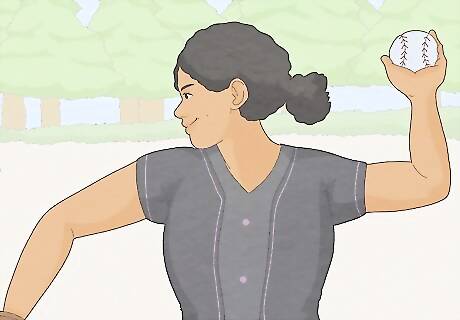
Improve pitching mechanics. The best pitchers don’t rely simply on their arms to whip the ball toward the plate. Instead, they use their entire bodies, and especially their legs and core muscles, to propel the ball forward. An effective and repeatable pitching motion reduces stress on the smaller shoulder muscles around the rotator cuff and makes arm soreness less likely to return when you resume pitching. While resting a sore arm, watch videos of good pitching motions, as well as of your own if you can. Talk to experienced pitching coaches to help develop a motion that works for you, that can be repeated consistently, and that will reduce strain on your arm. If you are into even more advanced technology, new arm sleeves have been developed that can track and analyze key data like arm motion, angle, and torque. This is probably more applicable to a big leaguer than a little leaguer, though.
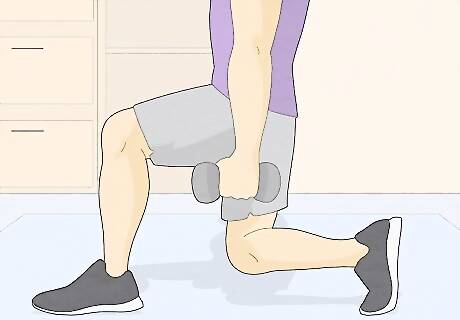
Focus on conditioning key muscle groups. Professional pitchers with “explosive” fastballs tend to have thick, powerful legs and well-developed core muscles. They do exercises specifically designed to increase muscle strength while maintaining flexibility in the leg, core, and shoulder areas. Pitchers at any level can also benefit from such exercises, and many elements of the regimen can be continued even while resting a sore arm. Cut out or limit the arm exercises while resting a sore arm, but continue to work on your core and legs. The more developed they become, the more likely you are to prevent future arm soreness. Especially focus on strengthening your shoulder, rotator cuff, and upper back. In addition, work on your range of motion and stability in your shoulder, as well as the posture in your shoulders, upper neck, and back.
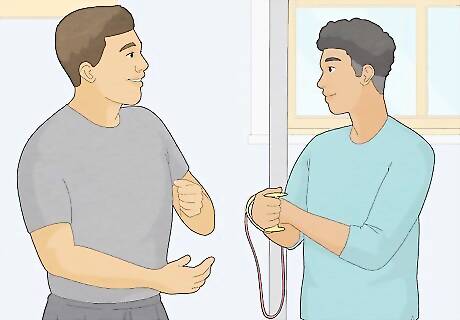
Consult with an expert. If pitcher’s arm has been a common problem for you, then a sports trainer, physical therapist, sports medicine doctor, or pitching coach, may be able to help you develop a “global strengthening program” to increase muscle stability and strength. The “Thrower’s Ten Program” is one such example — it includes ten simple exercises that utilize resistance bands, dumbbells, and an exercise ball.




















Comments
0 comment